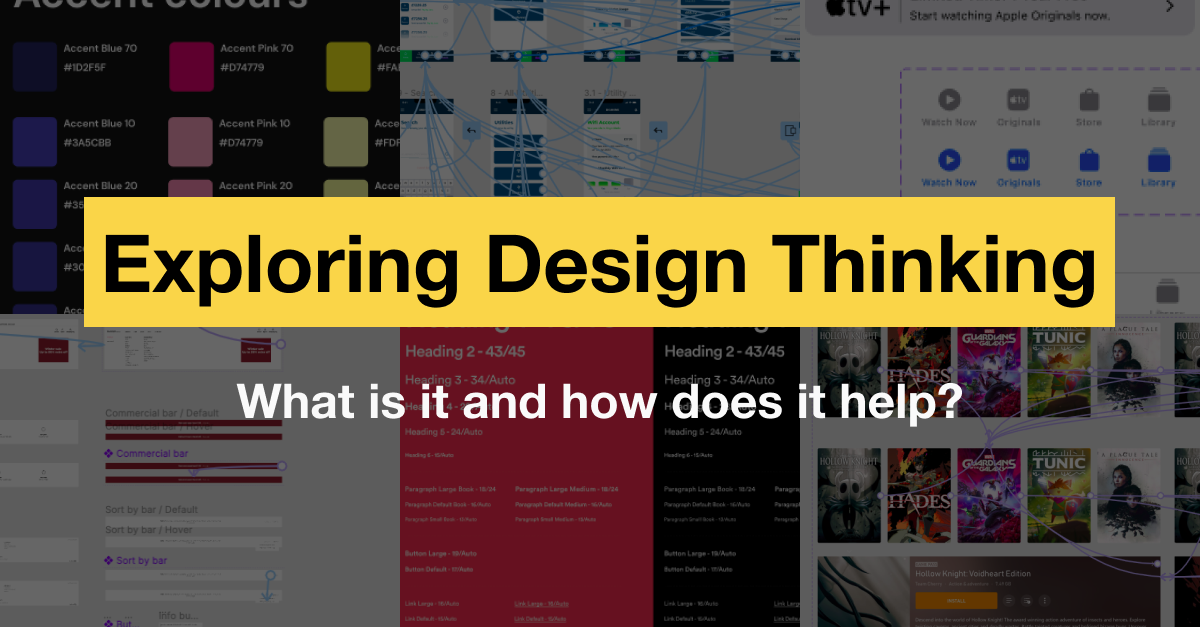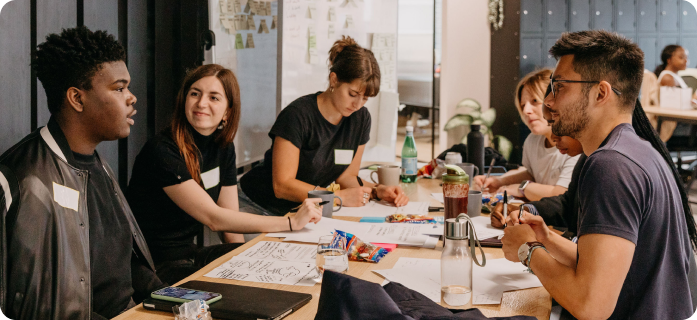Exploring Design Thinking – What is it and how does it help?
Defining Design Thinking
Before we get started on exploring Design Thinking, it is important to discuss the challenge of actually defining ‘Design Thinking’.
There are two key words that make this up: design and thinking. It’s hard enough to define these concepts, let alone the two of them combined as design thinking as an approach (Rylander, 2009).
If you ask anyone who has discussed, used or regularly applies design thinking inside their business to help with problem solving, it is not surprising that many of them cannot exactly explain what design thinking is, the origins and how it was shaped.
Even the articulation of why it should be used is often difficult to arrive at – who needs to be involved? How long does it take? Why should non-designers inside organisations take notice? Sometimes teams and companies are actually applying design thinking without knowing it.
If you were to ask those that are around the design industry what design thinking actually means, it’s almost certain you will get different answers each and every time. The reality is that design thinking is quite complex and involves many strategic and creative approaches. It is more holistic than one can imagine. But done well, the output from the framework can be powerful.
At a high-level, design thinking is an iterative process that can be used to solve problems. Design thinking can be applied into any type of design work, regardless of discipline. It remains true that whole approach is what is good (and fun!) about the design practice. The divergent and convergent thinking, the iteration, the people that need to be involved, the ideating and testing of ideas – it’s all creative problem solving. And this problem solving has been a large part of the designers role almost forever.
The term design thinking has grown in prominence over the last 10-15 years largely due it’s commercial use and social awareness. This approach takes the design process and methods and brings them to the limelight – in many cases however there is work done behind the scenes that no one sees (especially clients) that are truly powerful and help with decision making (Dorst, 2011)
The global design agency, IDEO, is often the company that is often credited with coming up with the approach of “design thinking” and it’s practical application. But the whole approach around design thinking is actually something that has been around for a lot longer (going back to the 1970s as a foundation) in fact, and has been slowly been applied with formal identification only just recently.
At Experience Haus, we truly believe it requires a shift in mindset, and if done well, it’s value moving forward is immense. If you compare it to more scientific approaches, that have been around for centuries, design thinking as a more practical (and perhaps applicable) approach has been around for 10-15 years, so it is essentially in it’s infancy. It is still far from global widespread adoption – in many cases teams look at the individual stages and use them to guide the development of products and services, but we will look at the why the mindset shift is actually more important.
The Framework
The design thinking framework aims to help inspire creative problem solving and strategic thinking that will help designers (of all kinds) create value-driven products and services, across various industries and sectors. (Kolko, 2015)
It is not, however, as it may seem, a linear path. Working through the stages in one defined path can often lead to failure. Iteration is key, and the willingness/need to step back as required. As you progress through the stages new ideas may come up and progress you forward, but new findings/gaps may come up that cause a need to step backwards to action further work.
Let’s take a look at each stage in further detail.
Empathy
This stage is where everything starts – in many way the foundational stage. It involves understanding the viewpoints of current and potential customers/users to see their views on current products and services, their behaviours and desires, the competitive landscape, and all done without bias.
If empathy is not something that designers have, there is a monumental task in place in order to design user-centred solutions. Empathy helps build a crucial understanding between the target audience and the product or service that is being potentially designed for them (Brower, 2021).
Other aspects that are often used at the stage include:
- Bringing in experts (often referred to subject matter experts, “SMEs” to ask about their views, experience and design insights.
- Contextual inquiry in order gain a more point of view perspective, essentially stepping into their shoes. Service safaris are where designers immersive themselves in a physical setting where a service, or product, is being current delivered.
- In-depth conversation and research with designers who have tackled this challenge in other industries, sectors or disciplines
This is a crucial stage as the motivations, behaviours, perspective, pain points and past experiences of the target audience will all help towards understanding how to solve the users problem.
Define
At this stage, after gathering useful data points through empathy, discussions with experts, and stakeholders, the design team brings together the design challenge that needs to be focused on. Identifying the customer segment, the problem areas and opportunities as well as a refreshed problem statement are all key here.
A lot of what happens in this stage can be referred to as data synthesis. The problem statement that comes together at the end is an expression of the design challenge that includes who will be targeted and why. This can take the angle of either a business-centred problem, or a human-centred problem.
Some of the questions here could include
- Who is our target user?
- What does their journey look like and where are the opportunities to improve it?
- What business objectives are we trying to meet?
- What does success look like?
- Who else do need to involve along the way?
Ideation
This stage is really where creativity gets to come into play. So much of what has been done so far is heavily based on empathy and data that sets up the ability to generate ideas that solve the design problem with creativity and innovation.
Initial ideation sessions may revolve around thinking “big”, and removing any kind of constraint, and then narrowing down to focus on an idea or two that are feasible and viable. It’s important to note that no idea is a bad idea, and that “bad” ideas can easily become good ideas with a slight twist. These ideations sessions are a must for designers as it builds up confidence around creative problem solving and the sharing of ideas.
The more ideas the better, as this provides more ideas for the team to discuss, investigate and potentially test to see how they solve the users problem.
It’s important to note that by now you should have a very good idea of your user base, so that you can focus on creativity and generating ideas for discussion.
Prototype
The previous stage brought us lots of ideas that we ultimately narrowed down through focusing on viability, feasibility and desirability (remember, design thinking is all about perspective, more on this later) – it is important to take an idea or two and see through testing if they actually solve the problem well. This is where a prototype (or early version) of the idea is needed. This should be done as quickly as possible, like paper sketches, or physical models using easy to access resources are needed.
At this stage it is all about building potential initial solutions rather inexpensively and at small-scale. They should include the features that will act as gain creators or pain solvers, which are decided through the process after understanding what pain points and motivations the user base has. When testing, there needs to be open discussion about works well and what doesn’t work well, and the open willingness to move backwards in the process if an idea doesn’t land well.
As we move forward into the testing stage, it is important to start to discuss what is needed to bring the product to reality – address any outstanding user experience issues, and testing to bring out further behaviours and expectations for the future.
Test
The final stage of the design thinking framework requires getting real, prospective and current users to review the product in order to gain real data that can be used to measure success and to learn from.
But calling this a “final” stage is not necessarily correct, as this framework, and designers in general, should be prepared to iterate and move backwards if needed. Iteration is what will bring a product closer to solving the problem well. Testing should be done thoroughly and comprehensively, as without this it is difficult for solutions to scale to a larger user base.
Design teams should be expecting to receive feedback that will require changes and refinements – this may cause a whole sequence of restarting the process especially moving back to the ideation or prototyping stage. New ideas will generated will require a refreshed approach, and teams should not be afraid to seek out tangents in discussion and thinking – which is where innovation may lie.




